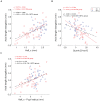The Spatial Distribution of Relative Corneal Refractive Power Shift and Axial Growth in Myopic Children: Orthokeratology Versus Multifocal Contact Lens
- PMID: 34177459
- PMCID: PMC8219929
- DOI: 10.3389/fnins.2021.686932
The Spatial Distribution of Relative Corneal Refractive Power Shift and Axial Growth in Myopic Children: Orthokeratology Versus Multifocal Contact Lens
Abstract
Purpose: To determine if the spatial distribution of the relative corneal refractive power shift (RCRPS) explains the retardation of axial length (AL) elongation after treatment by either orthokeratology (OK) or multifocal soft contact lenses (MFCLs).
Methods: Children (8-14 years) were enrolled in the OK (n = 35) or MFCL (n = 36) groups. RCRPS maps were derived by computing the difference between baseline and 12-month corneal topography maps and then subtracting the apex values. Values at the same radius were averaged to obtain the RCRPS profile, from which four parameters were extracted: (1) Half_x and (2) Half_y, i.e., the x- and y-coordinates where each profile first reached the half peak; (3) Sum4 and (4) Sum7, i.e., the summation of powers within a corneal area of 4- and 7-mm diameters. Correlations between AL elongation and these parameters were analyzed by multiple linear regression.
Results: AL elongation in the OK group was significantly smaller than that in the MFCL group (p = 0.040). Half_x and Half_y were also smaller in the OK group than the MFCL group (p < 0.001 each). Half_x was correlated with AL elongation in the OK group (p = 0.005), but not in the MFCL group (p = 0.600). In an analysis that combined eyes of both groups, Half_x was correlated with AL elongation (β = 0.161, p < 0.001).
Conclusions: The OK-induced AL elongation and associated RCRPS Half_x were smaller than for the MFCL. Contact lenses that induce RCRPS closer to the corneal center may exert better myopia control.
Keywords: axial length; corneal refractive power; multifocal soft contact lens; myopia; orthokeratology.
Copyright © 2021 Jiang, Huang, Xia, Wang, Lu, Zhang and Jiang.
Conflict of interest statement
The authors declare that the research was conducted in the absence of any commercial or financial relationships that could be construed as a potential conflict of interest. The reviewer ZC declared a past co-authorship with one of the author, JJ, to the handling editor.
Figures




References
-
- Akaike H. (1974). A new look at the statistical model identification. IEEE Trans. Automat. Contr. 19 716–723. 10.1109/tac.1974.1100705 - DOI
-
- Charman W. N., Mountford J., Atchison D. A., Markwell E. L. (2006). Peripheral refraction in orthokeratology patients. Optom. Vis. Sci. 83 641–648. 10.1097/01.opx.0000232840.66716.af - DOI - PubMed
LinkOut - more resources
Full Text Sources
Medical
Miscellaneous

